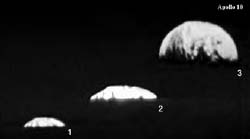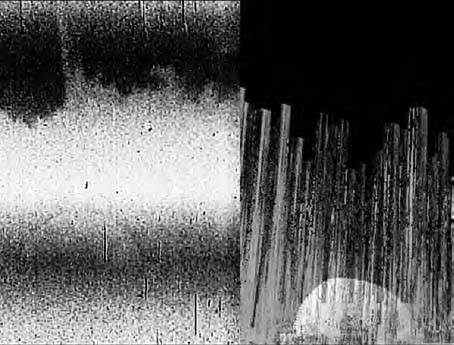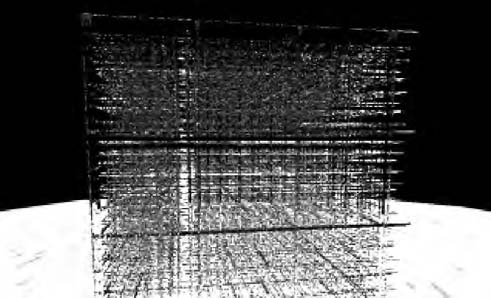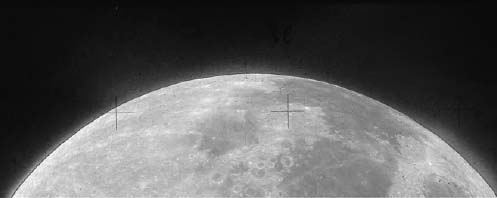Ancient Aliens on the Moon (10 page)
Read Ancient Aliens on the Moon Online
Authors: Mike Bara

Close-up view of the “Castle.” Note geometric internal structure and drooping support cable holding the structure up.
One of the biggest problems with this evidence of an Ancient Alien presence on the Moon is that the theorized lunar “dome” is just so hard for people to visualize. When I say dome, I’m not talking about a dome in the traditional sense like the domed stadiums we are so familiar with on Earth. What these structures really look like are tall, layered box-like structures designed to protect the vast cities below (like Los Angeles) from meteor bombardment. Again, this isn’t easy to picture, but back in the 1990’s award winning architect Robert Fiertek attempted to do just that.

Earthrise over Mare Smythii sequence.
Using all the available images that seemed to show evidence of this glass structure (including all the multiple versions of 4822), Fiertek painstakingly mapped and entered all of the visible points of light into a ray tracing program. He was inspired to do this because of a project he had conducted with 16mm footage of an Earthrise over a region of the Moon named Mare Smythii.
In this footage taken from the Apollo 10 mission, the Earth can be seen rising from behind the lunar horizon. But for some reason, the Earth looks distorted, flattened and compressed. This might not seem so unusual, since the Moon looks the same way when viewed from Earth.

Moonrise in the Earth’s atmosphere.
But again, the problem here is that the reason the Moon looks flattened and distorted is that the Earth has an atmosphere that bends the light and compresses the image of the Moon from the viewer’s perspective. But since the Moon has no atmosphere -at least none to speak of – this cannot be the reason that Earth looks so distorted as it rises. Once again, there has to some nearly transparent medium between the camera and the Earth to create this effect.

Final, overexposed frame from Earthrise over Mare Smythii film (left) and from Fiekrtek’s computer simulation of the transparent lunar dome theory (right).
Fiertek quickly realized that he had chance to disprove the entire lunar dome theory, so he set out to reproduce the effect with computer modeling. Plugging in his best guess for what this dome might look like, he was able to reproduce the distortion most effectively.

Theorized structure of the glass dome over Sinus Medii.
Taking this 3D model and tying it back in with the light source data he’d already entered from the Sinus Medii photos, Fiertek was then able to generate a viable computer simulation of the structure of the dome itself. The results were astonishing.
So this dome, as it were, is more like layer upon layer of steel-hard, transparent material, probably glass, protecting vast stretches of city-like infrastructure below. It must have taken eons, truly millions if not billions of years, for this immense and incredible feat of engineering to have eroded to the point it had by the time we went to the Moon and rediscovered it. As you will see, this unbelievable accomplishment is just the tip of the iceberg. There is much more to be found on the Moon, left behind and placed there by who knows who.
I’m not saying it was aliens… But…
What all of this leads us back to is Surveyor 4. If you remember, that was the robotic mission that disappeared while descending at high speed over Sinus Medii. The Surveyor 6 spacecraft that managed to land in the same region of the Moon safely and take the astounding after sunset lunar dome image from the surface was a replacement for this lost mission. In fact, it wasn’t until after that iconic photograph that NASA suddenly decided that Sinus Medii was suddenly unsuitable for the first lunar landing, even though it had been the first choice all along. What I strongly suspect is that NASA actually figured out what must have happened to Surveyor 4.
In short, it went “splat” like a bug on a windshield.
The evidence to support this contention is strong. First, keep in mind that the spacecraft was descending at several thousands of miles per hour at least, given that it was still over two minutes from its designated touchdown site. At that speed, even a minor scrape with an object like the Tower or the Shard would have destroyed the space vehicle. Second, Surveyor 6, rather than land in the same place and use the same approach vector, took a different approach vector and landed about ½mile from where Surveyor 4 was intended to touch down. Another tell-tale sign is the mysterious way in which the spacecraft simply ceased to exist. One microsecond it was there, the next it wasn’t. As I pointed out before, if there had been a chemical explosion, as NASA suggests, then the telemetry would have recorded this rather slow moving process as one system after another on the spacecraft was destroyed by the chemical explosion. Instead, the spacecraft simply blinked out of existence. Also, if NASA truly thought there was a malfunction with Surveyor’s descent rockets, wouldn’t they have tested that thesis and made some improvements to the system? In reality, they did not.
This disappearance then can only be explained by one of two possibilities. Either Surveyor 4 was sucked into some sort of hyper-dimensional wormhole created by the Moon’s Ancient Alien defense systems, or it hit something so fast that not even the light-speed radio transmissions from the onboard computer had time to record it. For obvious reasons, I favor the latter scenario.
At first, it may seem implausible. After all, wouldn’t the spacecraft’s sensitive telemetry also record the considerably slower-than-light impact against the towering glass structures we’ve speculated are littering the Sinus Medii region? Theoretically, yes they would. But the cool thing about conventional physics is there are always exceptions to virtually every rule. A case in point; the “scissors effect.”
Put simply, the scissors effect is an example of the fallacious idea that nothing can travel faster than light (see
The Choice).
It says that if a pair of scissors were suddenly closed at speeds approaching light speed (1.0c), then the theoretical intersection point between the two blades would (and must) exceed the speed of light. So if the 2 end points of the blades were closed at 0.9c, the intersection point (which exists only mathematically) would exceed 1.8c, or 1.8 times the speed of light. Of course, this calculation ignores the fact that if the two blades actually touch at the point of intersection, as they do in real scissors, then theoretically the blade tips can’t get anywhere near the speed of light. But hey, that’s a real-world application, and these are physicists so…

Illustration of the “scissors effect”
Anyway, the point is, stuff
can
exceed the speed of light under certain circumstances. So if, as an example, Surveyor 4 were descending at thousands of miles per hour and it’s antenna were suddenly deflected by impacting a giant, immovable object (like say a two times stronger than steel lunar tower extending miles high into the sky above the lunar surface), then the signal might very well be lost so quickly that data about the impact might not be recorded or transmitted back to Earth at all.
Hence, splat! As in a faster-than-light splat.
If any further evidence was needed to prove out the thesis that there is an immense, miles-high, lattice-work type transparent structure above large portions of the Moon, it was provided a few years ago. Shortly before going to publication on our book
Dark Mission
, my co-author Richard C. Hoagland found a new image of the Moon from the Apollo 15 mission that seemed to seal the deal. Apollo 15 photograph AS15-88-12013 was taken by the astronauts from the Apollo 15 command module Endeavour shortly after “Trans Earth Injection,” the firing of Endeavour’s main engine to break lunar orbit and begin the return trip to Earth. Looking back at the Moon and with the sun behind them, the astronauts snapped a photo with one of the hand-held 70mm Hasselblad cameras they took on the mission. What the photo shows is truly astonishing.

Apollo 15 photograph AS15-88-12013.
Under enhancement, the photo shows what appears to be a misty, billowy “air-glow” limb around the Moon, Stretching literally miles-high above the surface. Scattering the light into the blue end of the spectrum – exactly as an atmosphere would—it looks for all the world like the Moon has a dense atmosphere. But a closer examination reveals that is the least likely explanation.
